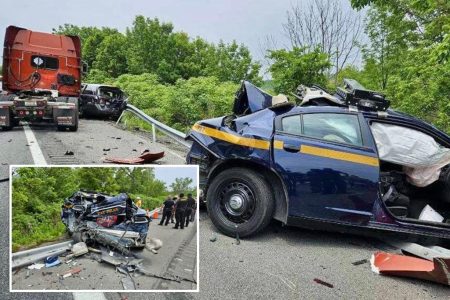The pre-dawn hours of a Saturday in Brazil witnessed a catastrophic bus accident that claimed the lives of over 30 passengers, casting a pall of grief and raising urgent questions about road safety. A packed bus, en route from Sao Paulo to Bahia, collided with a truck on the BR-116 federal highway near Teofilo Otoni in Minas Gerais. The impact ignited a fierce blaze, engulfing the bus and trapping many passengers inside. The scene that unfolded was one of utter devastation, with rescue workers battling the flames and tending to the injured amidst the wreckage.
Out of the 45 individuals on board the bus, the Minas Gerais Fire Department confirmed the death of 38, including the driver. The surviving passengers sustained critical injuries and were immediately transported to a local hospital for urgent medical care. The truck driver involved in the collision fled the scene, while three occupants of a car that also collided with the truck and subsequently became trapped beneath it, remarkably survived the ordeal. The accident left a trail of destruction and loss, impacting numerous families and communities.
The tragedy prompted a swift response from Brazilian President Luiz Inacio Lula da Silva, who expressed his profound condolences and offered government support to the victims’ families and the survivors. Via social media, he conveyed his deep sorrow and prayers, assuring those affected that the government would provide necessary assistance. The Federal Highway Police were dispatched to the scene to commence investigations and manage the aftermath of the accident.
The cause of the accident remained unclear, with conflicting accounts emerging from witness testimonies, necessitating a thorough forensic investigation. Initial reports from the fire department suggested a tire blowout on the bus led to the driver losing control and colliding with the oncoming truck at approximately 4 a.m. local time. This narrative, however, was challenged by witness accounts pointing to a dislodged granite block from the truck as the potential cause of the collision. The block allegedly fell onto the highway, obstructing the bus’s path and leading to the devastating impact.
The BR-116 highway, a vital artery connecting the densely populated southeast of Brazil to the economically challenged northeast, became the scene of this horrific tragedy. The incident underscores the vulnerability of road users and the potential for catastrophic consequences when accidents occur, especially on major thoroughfares. The loss of life, the severity of the injuries, and the conflicting accounts of the incident’s cause all contribute to the complexity and gravity of the situation.
The forensic investigation will be crucial in determining the definitive cause of the accident and providing answers to the grieving families and the public. Whether it was mechanical failure on the part of the bus, a detached load from the truck, or other contributing factors, the investigation’s findings will be vital in preventing similar tragedies in the future. The incident serves as a tragic reminder of the importance of road safety regulations, vehicle maintenance, and responsible driving practices to safeguard lives on the road.










